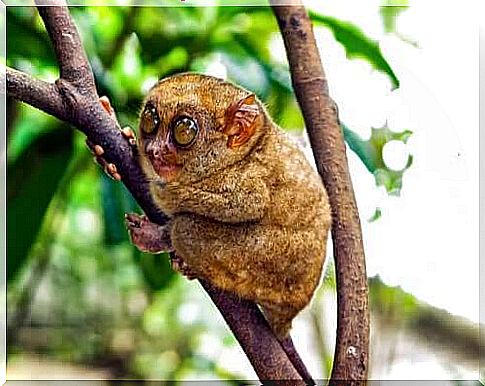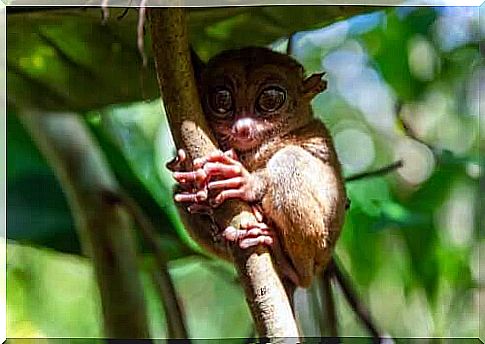Tarsius: A Peculiar Face That Struggles To Survive

Tarsius is a species of tarsiform primate endemic to Indonesia. It is a very little known animal that is currently classified as vulnerable. In this article, you will learn more about the tarsi, its habitat, its diet and its reproduction.
Characteristics and taxonomy of tarsius
Tarsius monkeys form a peculiar family of primates belonging to the genus Tarsius . When they were originally discovered, they were cataloged as lemurs. However, currently, it is known that they are not related to these animals, but to monkeys.
The best known species of tarsier is the Tarsius tarsier . The few fossils of this species discovered date from the Eocene, a geological period that took place more than 55 million years ago.
Research indicates that these animals are very ancient and may be one of the most primitive species among the tarsiforms. Currently, the tarsi monkeys are the only surviving family of this subgroup, as the other tarsiform families are already extinct.
Morphological aspects of the tarsius
Tarsius monkeys are small animals. Its body usually measures 9 to 14 centimeters in adulthood, but the tail can reach up to 26 centimeters in length. Also noteworthy is the lightness of this animal, with an average body weight of 100 to 115 grams for women and 118 to 130 grams for men.
As representatives of haplorrhines, one of the most typical morphological characteristics is the absence of protective membranes in the noses. These animals also lack stiff hair—the popular mustaches—in the snout region, like most large lemurs.

Another striking feature of the Tarsian monkeys is their really large eyes. In fact, for many experts, tarsiers have the largest eyes for body size among all mammals.
Although their trunks are small, they have very long feet, which help them stay between trees. Comparatively, they are larger than many lemur representatives, have a diametrically larger brain and have better eyesight – being able to distinguish several colors.
It’s also worth mentioning that Tarsian monkeys are able to turn their heads 180 degrees. Visually, it is a feature that arouses a lot of curiosity.
Habits and feeding of tarsi monkeys
Tarsians are nocturnal animals that live in trees. The morphological structure of this animal gives it the incredible ability to glide, jump and hold trees. They usually move and live on the middle branches, about two meters above the ground.
It is a species of very reserved character, so it is hardly seen in its natural habitat. In fact, the indigenous peoples of Indonesia used to consider them demonic or ghostly beings because of their habits. This explains why the common tarsius ( Tarsius tarsier ) is also known as the phantom tarsius.
Their diet is strictly carnivorous and is mainly based on the consumption of insects or larvae. However, Tarsian monkeys can also hunt invertebrates, reptiles, rodents and even small birds.

Habitat and reproduction of the tarsius
As mentioned in the introduction, tarsius is an indigenous species and endemic to Indonesia. More specifically, its largest population occurs on Celebes Island, but it also encompasses Togian, Muna, Kabaena, Buton and Selayar Islands.
In their habitat, tarsiers can form small groups of three to six individuals. However, females generally accept day and night living with males during mating seasons. In turn, males are very aggressive with each other, as they fight for the conquest of females.
Currently, species of monogamous and polygamous tarsi monkeys are known. The female tarsi has an important reproductive capacity compared to other species of haplorrhine, which consists of the presence of a bicornuate uterus.
The gestation of female tarsi monkeys lasts about 200 days. Females only give birth to one child in each pregnancy. They take care of the offspring until the chick is able to survive on its own.
Tarsius life expectancy is estimated to be between 10 and 12 years in its natural habitat. However, they can live up to 17 years in captivity, although this is not the ideal situation for these animals.








